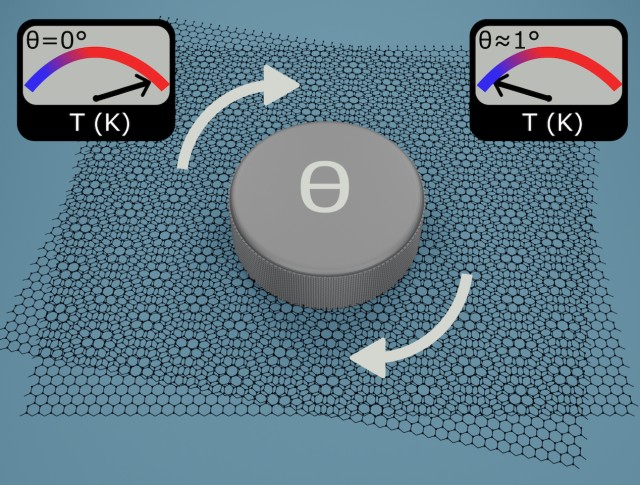27 February 2024
Unveiling Secrets of Electron-Phonon Interactions
An international team had been able to provide, for the first time, new insights into electron-phonon interactions occurring within twisted bilayer graphene. The research was conducted at ICN2, led by Dr. Klaas-Jan Tielrooij with worldwide collaboration, including the group of Prof. Dmitri Efetov, MCQST member and Chair of Solid State Physics at LMU München. The study has been published in the prestigious journal 'Science Advances'.
Back in 2018, researchers at the Massachusetts Institute of Technology (MIT) had already discovered the potential to alter the electronic properties of two stacked graphene layers through a subtle rotation. They indicated that slightly twisting the graphene layers at a specific ‘magic angle’ (referred to as MATBG henceforth) can transform the bilayer into either a flawless insulator or superconductor. In fact, despite this misalignment between the layers being extremely small (just a bit over 1 degree of rotation), the potential for achieving superconductivity or insulation was an astonishing outcome.

The results and future implications
This discovery was primarily conducted at ICN2. However, the worldwide collaboration played a crucial role in its completion. Klaas-Jan Tielrooij, group leader at Ultrafast Dynamics in Nanoscale Systems, and the team obtained the magic-angle twisted samples from Dmitri Efetov’s group at Ludwig-Maximilians-Universität in Munich. Efetov’s team was the pioneering group in Europe capable of producing such samples and studying them through photomixing measurements, which can reveal the real-time dynamics of the electrons. Theoretical contributions from MIT in the US and the Tokyo Institute of Technology in Japan were also pivotal to the research’s success.
Moreover, the work established the twist angle as an effective method for regulating energy relaxation. When light is absorbed, electrons acquire its energy and reach very high temperatures. Then, they will relax back to the equilibrium temperature through different cooling mechanisms. This process takes place rapidly in the MATBG – occurring within on a picosecond timescale, equivalent to one-millionth of one-millionth of a second. This discovery highlights a significantly accelerated cooling process at low temperatures (few Kelvin) in MATBG compared to a single layer of graphene. Furthermore, it points to the twist angle as the key to such enhanced electron relaxation. The research leader notes, “At low temperatures, it’s very difficult for electrons to lose energy to phonons, yet it happens in the MATBG.”
'It was exciting for us to observe such fast cooling of the electrons at low temperatures. In these conditions, many of the pathways for the electrons to relax their energy become restricted and the cooling time increases significantly. Furthermore, we were able to identify a novel mechanism for cooling that is unique to this family of twisted 2D materials, says Rafael Luque Merino from Efetov’s group at LMU München.
The future implications of these findings, as highlighted by Tielrooij, extend to the realm of charge transport dynamics and hold promise for the development of advanced ultrafast optoelectronics devices. Particularly advantageous in low-temperature environments, twisted bilayer graphene emerges as a fitting candidate for applications in space and quantum technologies. The identified interactions between electrons and phonons are anticipated to exert a significant influence on the understanding of the electronic and optoelectronic properties of this material, foreshadowing its potential role in future device technologies.
News originally published on the ICN2 website.
Publication
Ultrafast Umklapp-assisted electron-phonon cooling in magic-angle twisted bilayer graphene
J. D. Mehew, R. L. Merino, H. Ishizuka, A. Block, J. D. Merida, A. D. Carlon, K. Watanabe, T. Tanigughi, L. S. Levitov, D. K. Efetov, K.-J. Tielrooij
Science Advances, 10. DOI:
10.1126/sciadv.adj1361
Contact
Rafael Luque-Merino
PhD Student
Experimental Solid State Physics
LMU München
rafael.luque[at]lmu.de